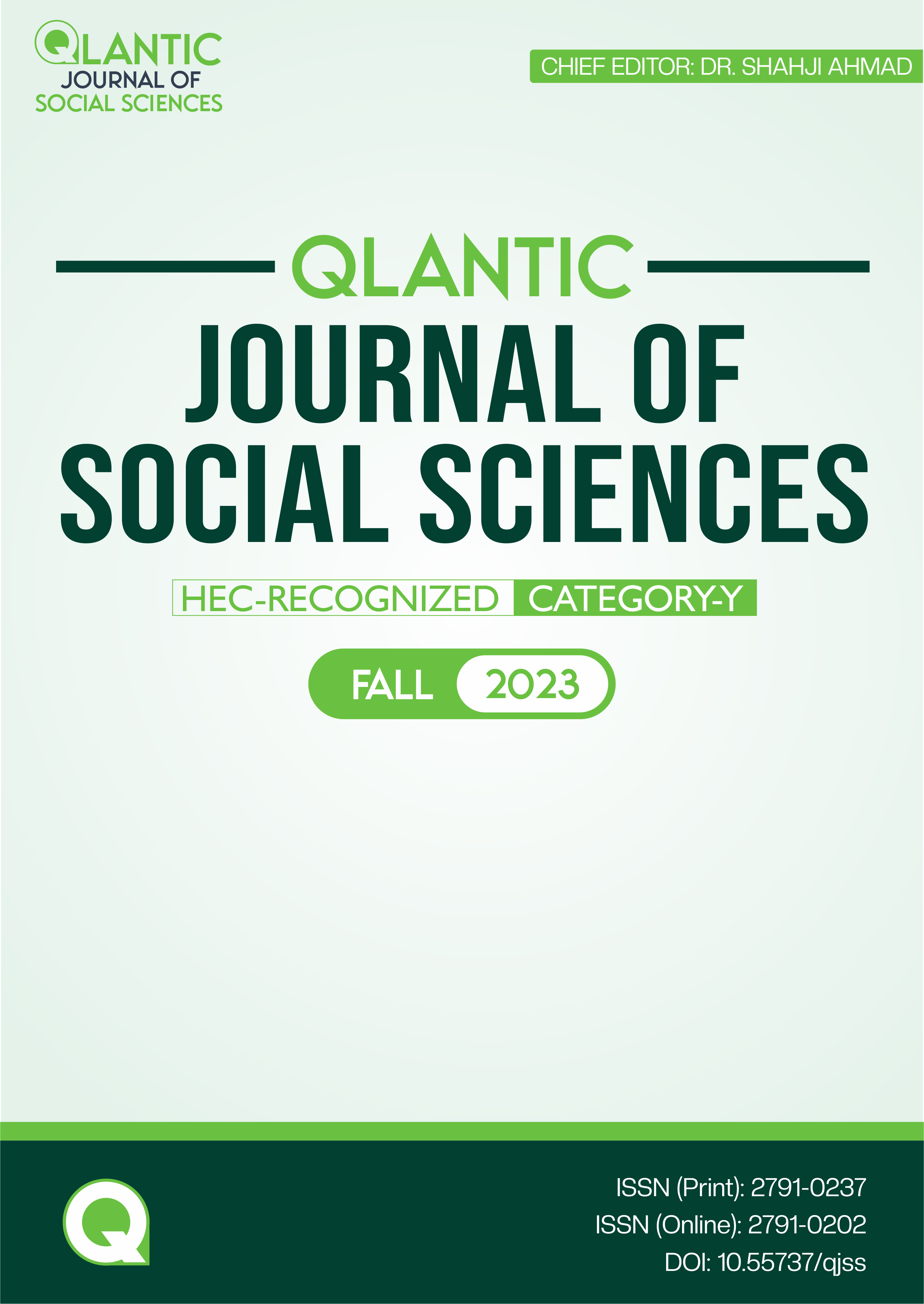Willingness to Communicate in English: Its Influence on Oral Proficiency Levels in ESL Learners
DOI:
https://doi.org/10.55737/qjss.107918956Keywords:
Willingness to Communicate, Oral Proficiency, English Language LearningAbstract
This study investigates the impact of Willingness to Communicate (WTC) on oral proficiency in English language learning, particularly focusing on its influence as an individual difference in second language (L2) acquisition. The research primarily aims to explore the correlation between WTC and oral language competency in L2 learners and examines how variations in WTC among learners with different levels of competency relate to other key factors such as self-confidence, the desire to communicate, and anxiety. Additionally, it assesses potential gender-based differences in WTC and oral proficiency. The participant group comprised 175 undergraduate students, including 88 males and 87 females. Data collection involved a comprehensive survey, and the analysis was conducted using the Statistical Package for the Social Sciences (SPSS) version 26.0. The findings revealed significant correlations between the studied variables, although T-test analyses indicated no significant gender-based differences in WTC and oral proficiency. This research contributes to a better understanding of how self-confidence, a strong desire to communicate, and a stress-free learning environment are crucial for successful language learning, thereby informing language education practices and policies.
Downloads
References
Aquino, K., & Thau, S. (2009). Workplace victimization: Aggression from the target's perspective. Annual Review of Psychology, 60(1), 717-741. https://doi.org/10.1146/annurev.psych.60.110707.163703
Bukhari, S. F., Cheng, X., & Khan, S. A. (2015). Willingness to Communicate in English as a Second Language: A Case Study of Pakistani Undergraduates. Journal of Education and Practice, 6(29), 39-44. https://files.eric.ed.gov/fulltext/EJ1081256.pdf
Cao, Y. K. (2013). Exploring dynamism in willingness to communicate: A longitudinal case study. Australian Review of Applied Linguistics, 36(2), 160-176. https://doi.org/10.1075/aral.36.2.03cao
Cao, Y. K. (2014). A Sociocognitive perspective on second language classroom willingness to communicate. TESOL Quarterly, 48(4), 789-814. https://doi.org/10.1002/tesq.155
Chappell, F., & Williams, B. (2002). Rates and reasons for non-adherence to home physiotherapy in paediatrics. Physiotherapy, 88(3), 138-147. https://doi.org/10.1016/s0031-9406(05)60547-0
Cheng, Y., Horwitz, E. K., & Schallert, D. L. (1999). Language anxiety: Differentiating writing and speaking components. Language Learning, 49(3), 417-446. https://doi.org/10.1111/0023-8333.00095
Clément, R., & Kruidenier, B. G. (1985). Aptitude, attitude and motivation in second language proficiency: A test of Clement's model. Journal of Language and Social Psychology, 4(1), 21-37. https://doi.org/10.1177/0261927x8500400102
Clément, R., Baker, S. C., & MacIntyre, P. D. (2003). Willingness to communicate in a second language. Journal of Language and Social Psychology, 22(2), 190-209. https://doi.org/10.1177/0261927x03022002003
Gurler, D., Doyle, N., Walker, E., Magnotti, J., & Beauchamp, M. (2015). A link between individual differences in multisensory speech perception and eye movements. Attention, Perception, & Psychophysics, 77, 1333-1341. https://doi.org/10.3758%2Fs13414-014-0821-1
Gurler, I. (2015). Correlation between self-confidence and speaking skill of English language teaching and English language and literature preparatory students. Curr Res Soc Sci 1(2), 14-19. https://dergipark.org.tr/tr/download/article-file/49980
Macintyre, P. D., & Charos, C. (1996). Personality, attitudes, and affect as predictors of second language communication. Journal of Language and Social Psychology, 15(1), 3-26. https://doi.org/10.1177/0261927x960151001
Macintyre, P. D., & Gardner, R. C. (1991). Investigating language class anxiety using the focused essay technique. The Modern Language Journal, 75(3), 296-304. https://doi.org/10.1111/j.1540-4781.1991.tb05358.x
MacIntyre, P. D., Baker, S. C., Clément, R., & Conrod, S. (2001). Willingness to communicate, social support, andlanguage-learning orientations of immersion students. Studies in Second Language Acquisition, 23(3), 369-388. https://doi.org/10.1017/s0272263101003035
Macintyre, P. D., Clément, R., Dörnyei, Z., & Noels, K. A. (1998). Conceptualizing willingness to communicate in a L2: A situational model of L2 confidence and affiliation. The Modern Language Journal, 82(4), 545-562. https://doi.org/10.1111/j.1540-4781.1998.tb05543.x
McCroskey, J. C. and J. E. Baer (1985). Willingness to communicate: The construct and its measurement. https://typeset.io/papers/willingness-to-communicate-the-construct-and-its-measurement-4noiy4p4kc
Mcevoy, M. D., Hand, W. R., Furse, C. M., Field, L. C., Clark, C. A., Moitra, V. K., Nietert, P. J., O’Connor, M. F., & Nunnally, M. E. (2014). Validity and reliability assessment of detailed scoring checklists for use during perioperative emergency simulation training. Simulation in Healthcare: The Journal of the Society for Simulation in Healthcare, 9(5), 295-303. https://doi.org/10.1097/sih.0000000000000048
Mellalieu, S. D., Hanton, S., & O'Brien, M. (2004). Intensity and direction of competitive anxiety as a function of sport type and experience. Scandinavian journal of medicine & science in sports, 14(5), 326–334. https://doi.org/10.1111/j.1600-0838.2004.00389.x
Pawlak, M., Mystkowska-Wiertelak, A., & Bielak, J. (2016). Investigating the nature of classroom willingness to communicate (WTC): A micro-perspective. Language Teaching Research, 20(5), 654-671. https://doi.org/10.1177/1362168815609615
Shin, S., Lidster, R., Sabraw, S., & Yeager, R. (2016). The effects of L2 proficiency differences in pairs on idea units in a collaborative text reconstruction task. Language Teaching Research, 20(3), 366-386. https://doi.org/10.1177/1362168814567888
Takahashi, A. & Takahashi, H. (2015). Anxiety and Self-Confidence in Ancient Language Studies. Niigata University Language and Culture Research Department Bulletin.
Published
Issue
Section
License
Copyright (c) 2023 Samina Sarwat, Waheed Shahzad, Muhammad Anees, Syed Khuram Shahzad

This work is licensed under a Creative Commons Attribution-NonCommercial 4.0 International License.




